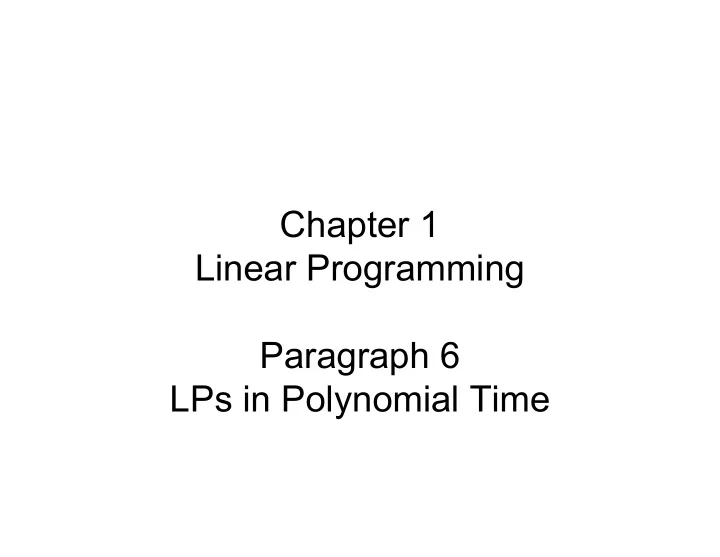

Chapter 1 Linear Programming Paragraph 6 LPs in Polynomial Time
What we did so far • We developed a standard form in which all linear programs can be formulated. • We developed a group of algorithms that solves LPs in that standard form. • While we could guarantee termination, and the “average” runtime is quite good, the worst-case runtime of Simplex and its variants may be exponential. • We shall now look into other algorithms for solving LPs in polynomial time – guaranteed! CS 149 - Intro to CO 2
The Ellipsoid Algorithm • Whether or not LP was in P was a long outstanding question. • Only in 1979, Soviet mathematician Khachian proved that an algorithm for non-linear convex minimization named Ellipsoid Method could actually solve LPs in polynomial time. • The method has important theoretical implications. However, the performance is so bad that its practical importance is immaterial. CS 149 - Intro to CO 3
The Ellipsoid Algorithm • It can be shown that Linear Programming is polynomially equivalent to finding a solution to a system of strict linear inequalities (LSI): Ax < b. • It can further be shown: – If an LSI is solvable, then so is the bounded system • Ax < b • –2 D < x i < 2 D where D is the binary size of the LSI. – If an LSI has a solution, then {x | Ax <=b} must have a minimal volume of 2 -(n+1)D . CS 149 - Intro to CO 4
The Ellipsoid Algorithm • The Algorithm works as follows: 1.Find an ellipsoid that is guaranteed to contain all solutions to the system. 2.If the center of the ellipsoid is feasible: return success! 3.If the volume of the ellipsoid is too small: return not solvable! 4.Using a violated constraint, slice the ellipsoid in half so that one side must contain all solutions. 5.Construct a new ellipsoid that covers the solution containing half-ellipsoid and go back to step 2. CS 149 - Intro to CO 5
The Ellipsoid Algorithm CS 149 - Intro to CO 6
The Ellipsoid Algorithm CS 149 - Intro to CO 7
The Ellipsoid Algorithm CS 149 - Intro to CO 8
The Ellipsoid Algorithm • Crucial to the polynomial runtime guarantee is the following key lemma: – Every half-ellipsoid is contained in an ellipsoid whose volume is less than e -1/2(n+1) times the volume of the original ellipsoid. • Corollary – The smallest ellipsoid containing a polyhedron P has its center in P. – The inner loop of the ellipsoid algorithm is carried out at most a polynomial number of times. CS 149 - Intro to CO 9
Implications • The two most important implications of the ellipsoid algorithm are: – LPs are solvable in polynomial time. – A linear program is polynomial time solvable even if all we can do efficiently is to provide a violated hyperplane when a suggested solution is violated. • An algorithm that does the latter is called a separation oracle. If we can provide a violated linear constraint in polynomial time, we can even solve LPs with an exponential number of constraints! CS 149 - Intro to CO 10
Constraint Generation for a Lower Bound of TSP • The Traveling Salesman Problem – Given a weighted graph (V,E,c), find a roundtrip that visits each node once such that the total distance is minimal. – We formulate this an integer program (IP): 1. Min Σ (i,j) ∈ E c ij x ij such that 2. Σ j:(i,j) ∈ E x ij = 1 for all i ∈ V 3. Σ i:(i,j) ∈ E x ij = 1 for all j ∈ V 4. Σ i ∈ S, j ∈ V\S x ij ≥ 1 for all ∅ ⊂ S ⊂ V 5. x ij ∈ {0,1} • To get a lower bound on the objective, we can relax (5) to x ij ≥ 0. But: The number of constraints is exponential! • Can we find a separation oracle? CS 149 - Intro to CO 11
Interior Point Algorithms • Linear Programming is also polynomially equivalent to finding the maximum objective value of max p T x, Ax ≤ b whereby for {x | Ax ≤ b} it is easy to find an interior solution. • What prevents us actually from using methods from calculus to solve our problem? • The non-differentiable shape of the polytope (corners!) causes problems. • Can we smoothen the shape of the feasible region? CS 149 - Intro to CO 12
Interior Point Algorithms • Instead of enforcing that solutions are within the feasible region via inequalities, instead we can make solutions more and more unattractive the closer we get to the border. • This idea yields to the notion of barrier functions: – A barrier function goes to - ∞ as Ax → b and should be differentiable. – max p T x + α ( Σ i log (x i ) + Σ i log ( Σ j a ij x i – b i )) • Using standard methods from calculus, we can maximize such functions ⇒ Newton method • By decreasing the barrier parameter α , we get closer and closer to the true maximal value. CS 149 - Intro to CO 13
Interior Point Algorithms α = 1 α = 0.25 α = 0.5 α = 0.125 CS 149 - Intro to CO 14
Interior Point Algorithms CS 149 - Intro to CO 15
Thank you! Thank you!
Recommend
More recommend